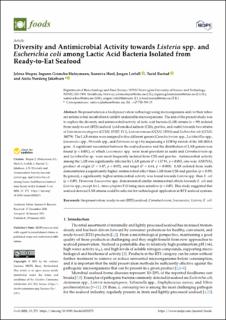| dc.description.abstract | Biopreservation is a food preservation technology using microorganisms and/or their inherent antimicrobial metabolites to inhibit undesirable microorganisms. The aim of the present study was to explore the diversity and antimicrobial activity of lactic acid bacteria (LAB) strains (n = 99) isolated from ready-to-eat (RTE) seafood (cold-smoked salmon (CSS), gravlax, and sushi) towards two strains of Listeria monocytogenes (CCUG 15527, F11), Listeria innocua (CCUG 15531) and Escherichia coli (CCUG 38079). The LAB strains were assigned to five different genera (Carnobacterium spp., Lactobacillus spp., Leuconostoc spp., Weissella spp., and Enterococcus sp.) by sequencing a 1150 bp stretch of the 16S rRNA gene. A significant association between the seafood source and the distribution of LAB genera was found (p < 0.001), of which Leuconostoc spp. were most prevalent in sushi and Carnobacterium sp. and Lactobacillus sp. were most frequently isolated from CSS and gravlax. Antimicrobial activity among the LAB was significantly affected by LAB genera (F= 117.91, p < 0.001, one-way ANOVA), product of origin (F = 3.47, p < 0.05), and target (F = 4.64, p = 0.003). LAB isolated from sushi demonstrated a significantly higher antimicrobial effect than LAB from CSS and gravlax (p < 0.05). In general, a significantly higher antimicrobial activity was found towards Listeria spp. than E. coli (p < 0.05). However, Leuconostoc spp. demonstrated similar antimicrobial effects towards E. coli and Listeria spp., except for L. monocytogenes F11 being more sensitive (p < 0.05). This study suggested that seafood-derived LAB strains could be selected for technological application in RTE seafood systems. | en_US |

